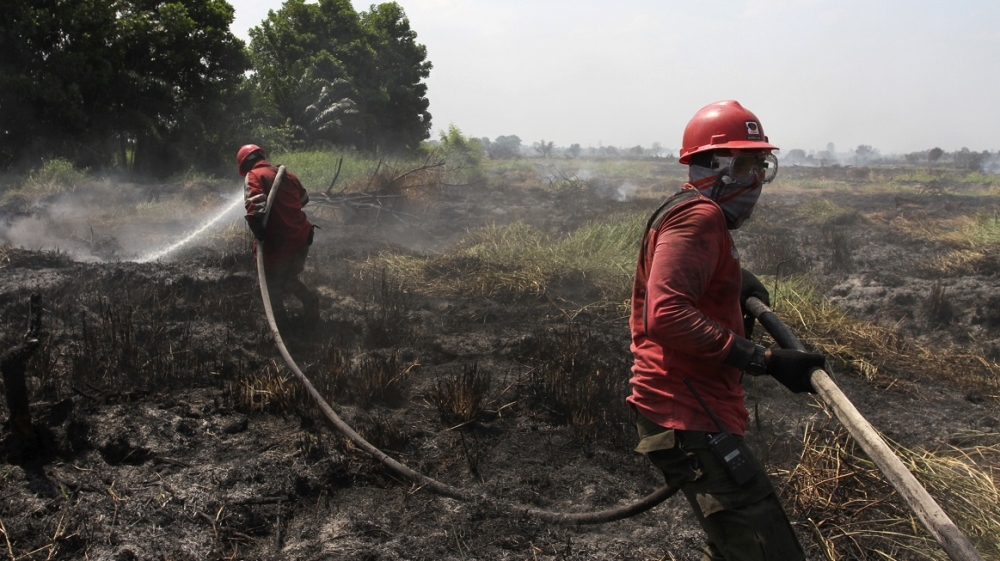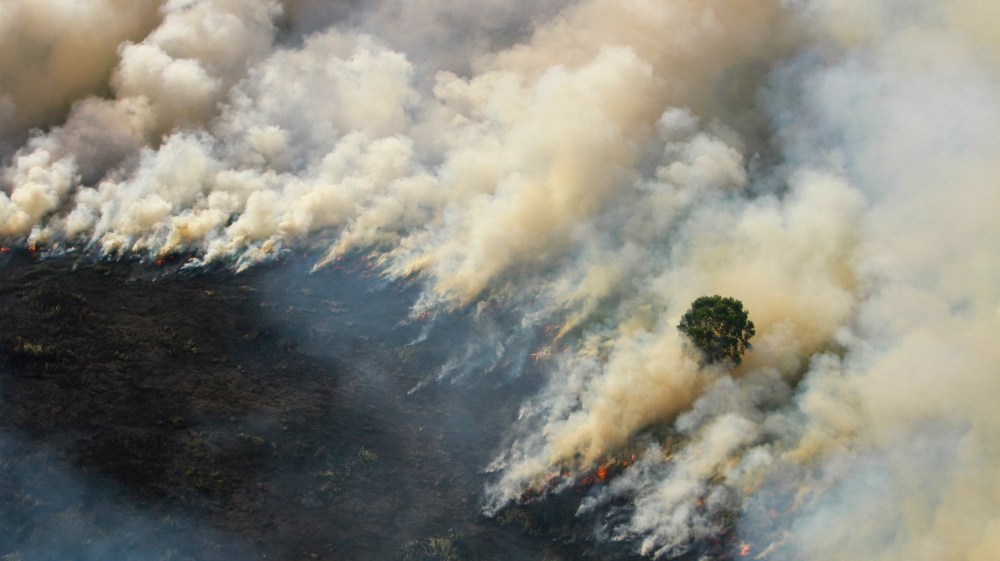
Kuala Lumpur, Malaysia – A regional agency monitoring land and forest fires in Southeast Asia has raised the alert on the danger of haze from Indonesia, as neighbouring Malaysia and Singapore woke up to smoke-filled skies on Tuesday.
The ASEAN Specialised Meteorological Centre (ASMC) warned that the “transboundary haze situation could worsen” in the coming days, with winds expected to continue blowing from the south towards the direction of the Malaysian Peninsula.
“Over the past few days, there has been a further escalation of hotspot activities and deterioration in haze situation in Sumatra,” the ASMC said in a statement posted on its website on Monday evening, as it issued its highest alert level, 3, for the Indonesian province.
“The smoke haze has been blown across the Strait of Malacca to western parts of Peninsular Malaysia by the prevailing winds.”
The Alert Level 3 is raised when dense smoke plumes are recorded on two consecutive days, and the number of hotspots exceeds 250. A total of 52 and 206 hotspots were detected in Sumatra on Saturday and Sunday, according to ASMC.
According to reports, this year’s El Nino warm-ocean pattern has contributed to the increase in forest fire hotspots to its highest level in four years.
The forest fires raging on the Indonesian island of Sumatra and the province of Kalimantan on Borneo island in recent weeks have prompted the Indonesian government to deploy 9,000 personnel to help stop them.
On Tuesday, Malaysia’s environment department reported a continuing rise in the air pollutant index (API) in Kuala Lumpur.
As of Tuesday morning, API levels in five areas in and around the capital rose to between 119 and 140, which are considered as “unhealthy”.
The country’s Ministry of Education has ordered schools in areas affected by the haze to cancel all outdoor activities. The order is compulsory when the pollutant index hits 100.
In September 2015, Indonesia declared a state of emergency in Sumatra after forest fires created a thick haze that spread across the region, including Singapore and Malaysia. The fire raged for days affecting Indonesia’s neighbouring countries across the Strait of Malacca.
Azrul Mohd Khalib, CEO of Galen Centre for Health and Social Policy, told Al Jazeera that compared with this year, the transboundary haze in 2015 was worse, because of the combination of smoke from peat fires and burning forests in the Sumatra and Kalimantan regions.
“However, the stakes and risks are increasing [this year] as this dry season may be more serious compared to what was experienced in the last few years,” he said.
Syed Hasnain Raza, an environmental researcher and wildlife filmmaker from Kuala Lumpur, told Al Jazeera that the recent thick haze has gotten him “really worried” about his health and that of his family.
“Something has definitely gone wrong. The last time that it was this bad was in 2015,” he told Al Jazeera. “The haze is just adding to the greenhouse gases, so it is really bad.”
Meanwhile, the city-state of Singapore reported a “moderate” API as a result of the smoke from the fires, according to the country’s National Environment Agency (NEA).
But it said districts in southern and eastern parts of the city were inching towards the “unhealthy” level, which is between 101 and 200.
“Singapore could experience slightly hazy conditions if the hotspot situation in Sumatra persists,” NEA said, referring to the Indonesian island’s ongoing fires.
#haze 90days ago & today. The 5th largest population might be blind for the love of growing #palmoil by ill practices. But #Sumartrafires are putting whole regions health & atmosphere at stake. LungsCancer has the highest number of deaths around the world #Singapore #Malaysia pic.twitter.com/322RDFvbV1
— Syed Hasnain Raza (@hasnain_sunny) September 10, 2019
Further escalation of hotspots
The issue of haze in Malaysia and Singapore has been a continuing source of friction with neighbouring Indonesia. On Friday, Kuala Lumpur hinted it would send a diplomatic note to Jakarta to address the cross-border haze.
But in a social media post on Sunday, Indonesia’s environment and forestry minister, Siti Nurbaya Bakar, denied that the haze had spread to other parts of the Southeast Asia region.
“It has been determined that until now, there has been no transboundary haze from Indonesia to neighbouring countries,” she wrote.
Siti said most forest fire incidents were caused by human factors.
ASMC, the regional monitoring agency, warned that dry weather in the region will continue in the coming weeks “and further escalation of hotspots activities in Sumatra is possible”.
Elsewhere in Indonesia, ASMC reported that “persistent hotspots continued to be detected” in many parts of Kalimantan, also affecting Sarawak, the Malaysian part of the island of Borneo.
According to reports, there have been over 6,000 hotspots in Kalimantan.
In Sarawak, Malaysia’s state education agency ordered hundreds of schools in eight districts, including in the state capital of Kuching, to close because of the poor air quality.
“Some smoke haze was also observed to extend over the adjacent South China Sea area.”
ASMC raised the alert to the highest level in Sarawak last Thursday.
Among those who are relatively healthy, with previous serious health conditions, exposure will likely cause irritation in the eyes, nose and throat, according to Azrul, of the Galen Centre.
But those who already have chronic lung or heart disease, as well as children and elderly, are vulnerable to complications such as breathing difficulties and asthma, he added.
“Fortunately, Malaysia’s exposure to haze is short-term and does not occur throughout the year.”
Pressure on Jakarta
Forest fires are a familiar scene during the dry season in Indonesia.
But the pressure against Jakarta to end to slash-and-burn practises in tropical forests has been more intense this year, amid international outrage over the enormous forest fires in the Amazon.
In the past, the Indonesian government has promised to prosecute those who were responsible. But so far, there has been no reported progress on those cases. In 2016, police in Sumatra’s Riau province dropped charges against 15 companies, suspected of their roles in the fires in 2015.
Indonesia’s Walhi Environmental Group had blamed corporations who clear vast tracts of land under concession for being directly responsible for the fires, whether they were deliberately started or not.
The group has also criticised the state governments for failing to prosecute those major concessionaires and companies.
On Sunday, Siti, Indonesia’s environment and forestry minister, promised to prosecute those who were involved, saying: “We will continue to pursue and act decisively.”
“The Indonesian government continues to work hard for the interest of the nation, and we will not lose or let down on the pressures.”
According to Indonesia’s weather agency, BMKG, the dry season will last until October this year.







 Large swathes of land were also reported in Indonesia’s province of Kalimantan in Borneo island [File: Antara via Reuters]
Large swathes of land were also reported in Indonesia’s province of Kalimantan in Borneo island [File: Antara via Reuters]






